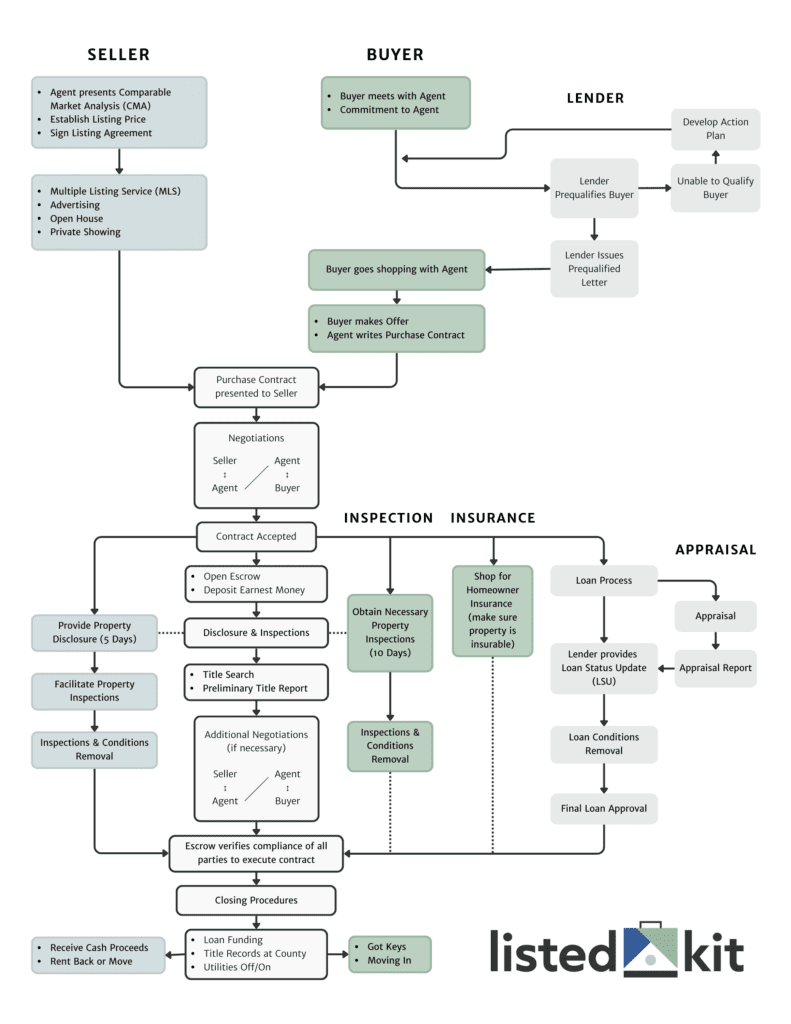Real estate transactions are a complex web of negotiations, paperwork, and processes. Whether you’re a seasoned realtor or new to the industry, understanding the flow of a real estate transaction is crucial to ensuring a smooth experience for both buyers and sellers. Below, you’ll find a simple sales process flow chart as well as descriptions for each step. Check it out!

1. Listing the Property
The process begins with the seller’s agent presenting a Comparative Market Analysis (CMA) to determine the property’s value in the current market. Once the listing price is established, the seller and their agent sign a listing agreement. This is the starting point for the sale.
2. Marketing and Showcasing
With the listing agreement in place, the property is added to the Multiple Listing Service (MLS) and advertised through various channels. Private showings and open houses are organized to attract potential buyers.
3. Buyer Engagement
As the property is being marketed, prospective buyers may seek out the services of a buyer’s agent. During this time, the lender works with the buyer to pre-qualify them for a mortgage and develop an action plan in case they face challenges in obtaining financing. The lender then issues a pre-qualification letter to the agent, indicating the buyer’s readiness to shop for a home.
4. Finding the Right Property
Once the buyer commits to an agent, they embark on the exciting journey of house hunting. When they find a property they love, they present a purchase contract to the seller, and negotiations begin.
5. Contract-to-Close Period
Once the purchase contract is accepted, the contract-to-close period comes into play. This period bridges the gap between the signing of the purchase contract and the finalization of the sale. During this phase, several essential tasks must be accomplished.
For the buyer, securing financing and conducting necessary inspections are top priorities. Meanwhile, the seller is responsible for furnishing property disclosures and facilitating inspections on their end.
The duration of the contract-to-close period typically spans 30 to 60 days, though it may vary depending on the transaction’s complexity. For instance, if the buyer requires financing, the loan process can extend over several weeks. Additionally, in competitive markets, sellers may need extra time to secure a replacement property.
For a comprehensive checklist of tasks to be completed during the contract-to-close period, click here.
Here are some valuable contract-to-close tips for both buyers and sellers:
- Be Responsive: Maintaining open lines of communication and responsiveness to your agent and other involved parties is crucial for keeping the process on track.
- Be Flexible: Unforeseen delays can arise during this period. Be prepared to adapt and collaborate with your agent to overcome any challenges.
- Stay Organized: Keeping meticulous records of all paperwork and deadlines involved in the transaction will contribute to a smooth and trouble-free process.
The contract-to-close period may be hectic, but effective organization and communication are key. Tools like ListedKit can assist by providing automated reminders based on important dates in your transaction. Additionally, it offers document management, accessibility, and digital signing capabilities. By working together efficiently, you can ensure a seamless and efficient conclusion to the sale of your property.
6. Closing Procedures
As the transaction approaches its final stages, a series of crucial steps come into play:
The lender disburses the funds, completing the financing process.
The property’s title is officially recorded at the county office, solidifying the ownership transfer.
Utility services are adjusted, either being transferred to the new owner or deactivated/activated according to the needs of the property’s new occupants.
These closing procedures are the culmination of a successful real estate transaction, marking the moment when ownership is officially transferred, and the keys to the property change hands.
Overall
Real estate transactions are intricate processes that demand careful coordination and collaboration among multiple parties. As a realtor, your role is pivotal in guiding both buyers and sellers through this journey, ensuring that each step is completed smoothly and according to the agreed-upon terms. By understanding the flow of a real estate transaction and the responsibilities of each party, you can provide a seamless and successful experience for your clients from listing to closing.
Streamline your real estate transactions with ListedKit
Are you tired of the chaos of real estate transactions?
ListedKit helps everyone know what to do and when to do it.



